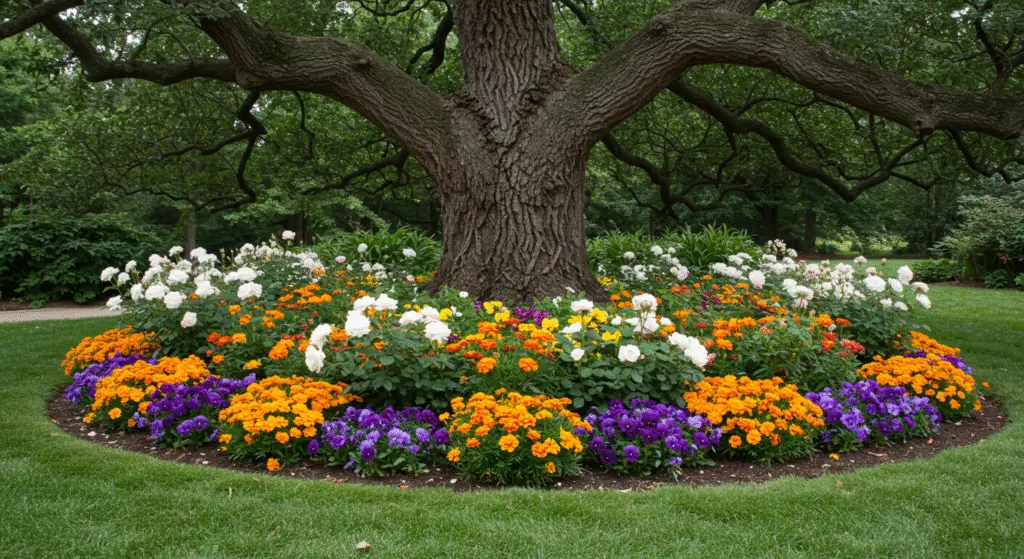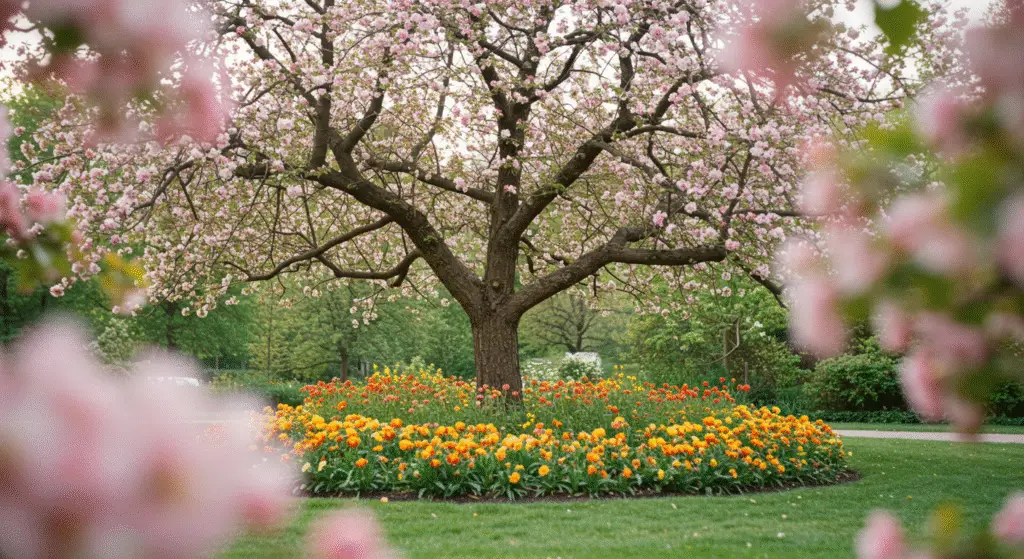
Creating a tree flower bed is one of the simplest ways to beautify the base of your trees and enhance the overall look of your landscape. Often, the space around a tree is ignored or left bare, but with thoughtful design, it can be turned into a colorful, welcoming, and healthy part of your garden.
This post offers inspiration and practical tips for designing a tree flower bed that not only looks great but also supports healthy plant growth and fits well with your existing outdoor space.
Choose the right spot and tree
Before you begin, it’s important to evaluate your tree and its surroundings. Certain trees are better suited for flower beds than others. Trees with shallow roots, such as maples and birches, may make planting more challenging, while those with deep roots, like dogwoods or some pines, offer more flexibility.
Also, consider how much sunlight filters through the branches throughout the day. A tree that allows dappled sunlight is ideal, as it provides the perfect light balance for many shade-loving plants.
Select the best flowers and groundcover
A successful tree flower bed depends on choosing plants that thrive in the unique conditions beneath a tree—limited light, potential root competition, and varying soil moisture. Look for shade-tolerant flowers and groundcovers that require minimal care once established.
Great plant choices include hostas, ferns, astilbe, bleeding hearts, coral bells, impatiens, and begonias. These options bring a mix of textures, colors, and seasonal interest that keeps the flower bed looking vibrant throughout the year.
Define your bed’s shape with clean edges
Designing the shape of your flower bed can elevate its appearance. Whether you prefer a circular bed, a natural organic shape, or something more structured like a square or rectangle, defining the edges gives it a tidy and intentional look.
Use edging materials such as bricks, stones, or flexible metal strips to separate the bed from the surrounding grass. This also helps prevent weeds and grass from creeping into the flower bed and competing with your plants.
Prepare your soil without damaging tree roots
When preparing a tree flower bed, be gentle with the soil. Avoid deep digging, as many trees have surface roots that can be easily damaged. Instead, lightly cultivate the top layer of soil and add a few inches of organic compost or enriched topsoil to improve nutrient availability.
Leave a gap around the trunk—don’t pile soil or mulch directly against it—as this can lead to decay and disease. Keeping the base of the tree exposed ensures good air circulation and tree health.
Use mulch for moisture and protection
Adding a layer of mulch helps regulate soil temperature, retain moisture, and reduce weed growth. Organic mulch such as bark, wood chips, or shredded leaves is ideal, as it breaks down over time and improves soil quality.
Apply mulch evenly, about two to three inches deep, but make sure to leave a clear space around the tree trunk. This layer of mulch supports both the tree and the surrounding plants, especially during hot or dry weather.

Mix flowers with varying colors and bloom times
Creating visual interest is all about combining plants with different heights, textures, and blooming periods. Start with taller plants or ornamental grasses around the outer edges, then fill in with medium-height flowers and groundcovers toward the center.
Using a mix of perennials and annuals offers both consistency and seasonal change. Perennials like daylilies and lungwort return each year, while annuals such as pansies and petunias can be rotated each season for fresh bursts of color.
Add decorative features and structure
Besides flowers, adding a few decorative touches to your tree flower bed can make it more inviting. A small birdbath, garden statue, or decorative rock can serve as a focal point without overpowering the plants.
Structure and balance are key. Try grouping plants in odd numbers, layering by height, or arranging by color to create flow and unity. Even a single tree can feel like a landscaped garden with the right mix of natural and decorative elements.
Maintain the bed for lasting beauty
Ongoing care keeps your tree flower bed looking its best. Weed control, deadheading spent blooms, replenishing mulch, and occasional pruning are all part of regular maintenance. Also, monitor the moisture levels of the soil—both the tree and flowers need adequate hydration, especially in dry conditions.
Over time, you may want to divide perennials to promote growth or refresh the layout with new plant combinations. Keeping your bed clean and tidy helps highlight the tree’s beauty while supporting the overall health of your landscape.
Final thoughts
Adding a tree flower bed to your garden is a simple yet impactful way to bring life, color, and charm to an often-overlooked area. With the right plant selection, thoughtful layout, and ongoing care, you can create a beautiful focal point that blends naturally into your outdoor space.
Whether you prefer a lush woodland style or a more structured and elegant design, a well-maintained flower bed under a tree can make a big difference in the look and feel of your garden.

Pingback: Garden and Lights Ideas to Transform Outdoor Spaces
Pingback: 10 Garden Shed Paint Ideas to Transform Your Outdoor Space
WGSd KQLU DHdIWbjo Vfuvaq XHPCvpiC DSTDYA
p033vl